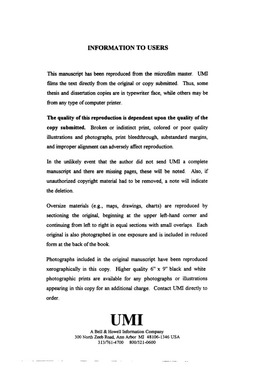| dc.contributor.advisor | White, Robert L., | en_US |
| dc.contributor.author | Sikabwe, Chandja Emmanuel. | en_US |
| dc.date.accessioned | 2013-08-16T12:29:47Z | |
| dc.date.available | 2013-08-16T12:29:47Z | |
| dc.date.issued | 1997 | en_US |
| dc.identifier.uri | https://hdl.handle.net/11244/5499 | |
| dc.description.abstract | Thermogravimetry (TG) was utilized to study catalyst thermal stability and to measure sulfate contents for catalysts with differing compositions. Temperature programmed desorption (TPD) measurements of surface adsorbed species were used to characterize catalyst acidities. Diffuse reflectance Fourier transform infrared spectroscopy (DRIFTS) and variable temperature diffuse reflectance Fourier transform infrared spectroscopy (VT-DRIFTS) were used to characterize adsorbate interactions with catalyst surfaces. Results from TPD studies suggested that metal promoters did not increase the acidity of sulfated zirconia catalysts. Based on TG and VT-DRIFTS studies, a potential structure for sulfated zirconia acid sites was proposed. | en_US |
| dc.description.abstract | Sulfated zirconia, a catalyst with potential to be used for low temperature hydrocarbon isomerization and alkylation reactions was studied. The work described in this dissertation represents a systematic study of the effects of synthesis procedures and metal promoter content on the properties of sulfated zirconia catalysts. Microcatalytic reactor studies revealed that the addition of metal promoters led to higher n-butane isomerization rates. The incorporation of nickel into sulfated zirconia catalysts had a similar promoting effect as adding both Fe and Mn. Catalysts containing only Mn were much less active than those containing only Fe or Ni. | en_US |
| dc.description.abstract | Thermogravimetry studies were augmented with chromatographic separation and mass spectrometric analysis of volatiles evolved during 1-butene TPD. Results from these studies suggested that metal promoted catalysts inhibited participation of surface carbenium ions in hydride abstraction reactions, resulting in more abundant unsaturated volatile products compared to the unpromoted catalyst. It was concluded that one role of metal promoters in n-butane catalytic isomerization may be to reduce the electrophilic nature of adsorbed carbenium ion intermediates. The magnitude of this effect depends on the type of metal employed as a promoter. | en_US |
| dc.format.extent | xix, 203 leaves : | en_US |
| dc.subject | Zirconium oxide Effect of iron on. | en_US |
| dc.subject | Zirconium oxide Effect of nickel on. | en_US |
| dc.subject | Chemistry, Analytical. | en_US |
| dc.subject | Zirconium oxide Effect of manganese on. | en_US |
| dc.subject | Catalysts. | en_US |
| dc.subject | Chemistry, Organic. | en_US |
| dc.title | Investigations of the effects of iron, manganese, and nickel on the properties of sulfated zirconia catalysts. | en_US |
| dc.type | Thesis | en_US |
| dc.thesis.degree | Ph.D. | en_US |
| dc.thesis.degreeDiscipline | Department of Chemistry and Biochemistry | en_US |
| dc.note | Source: Dissertation Abstracts International, Volume: 58-03, Section: B, page: 1259. | en_US |
| dc.note | Adviser: Robert L. White. | en_US |
| ou.identifier | (UMI)AAI9728719 | en_US |
| ou.group | College of Arts and Sciences::Department of Chemistry and Biochemistry | |
